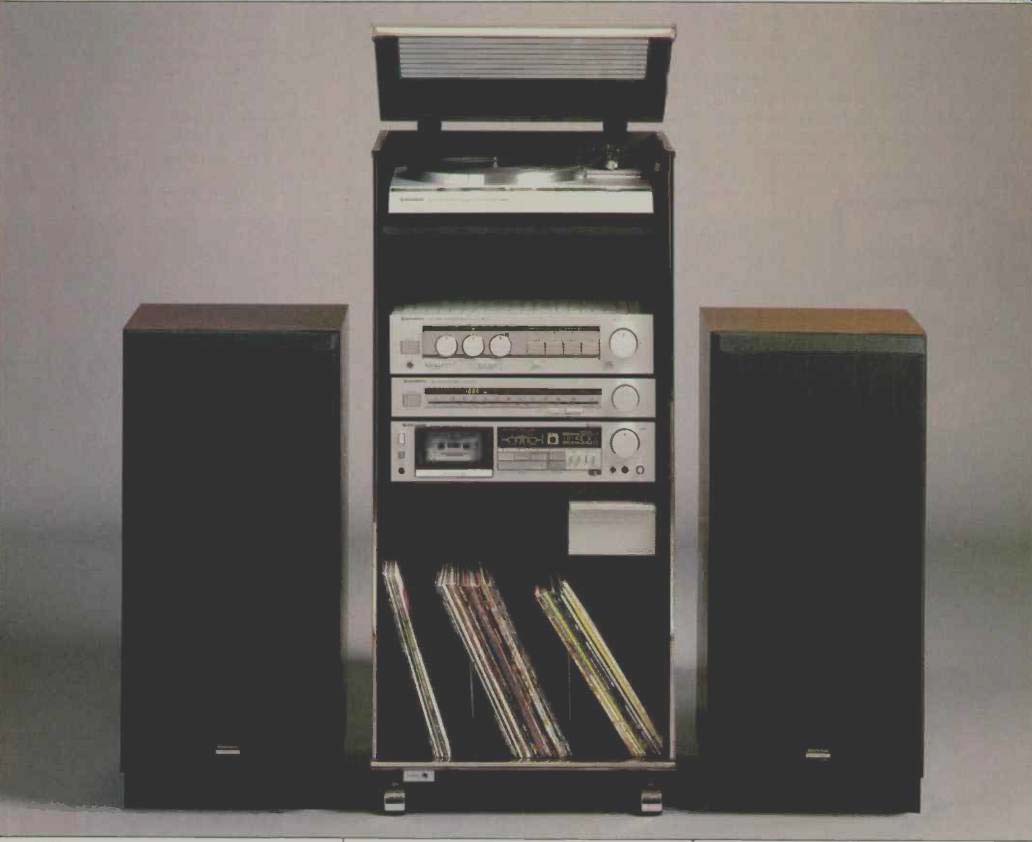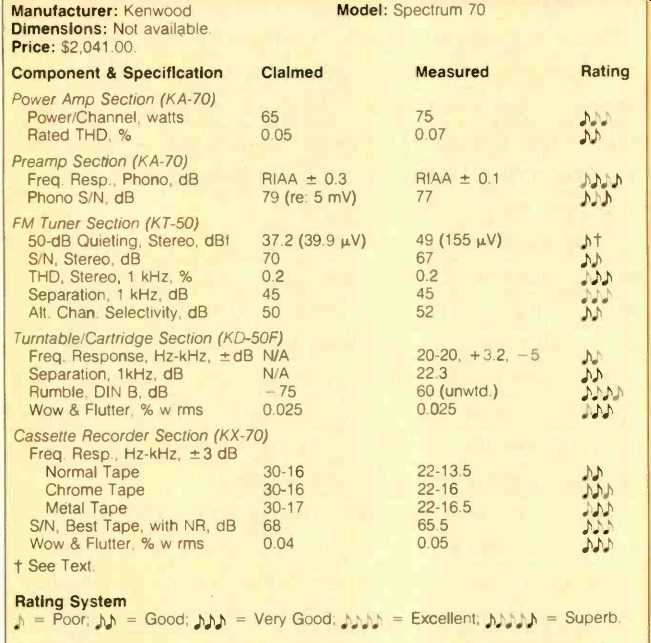
One-brand systems, among other attractions, offer audio connoisseurs an
economical solution for a second sound system in the home or an installation
at a summer place. Kenwood, which makes a fine line of home and car stereo
gear, recently introduced a novel video/audio integrated amplifier and now
has plunged into the burgeoning field of one-brand systems.
Kenwood's top-of-the-line Spectrum 70 system consists of an integrated amplifier (Model KA-70), an AM-FM tuner (Model KT-50), a direct-drive fully automatic turntable (Model KD-50F), and a cassette tape deck (Model KX70). Three-way speaker systems (Model JL800) are also supplied (though I did not include them in my tests). The system is housed in an attractive, simulated walnut-finish cabinet with a glass door and has a hinged glass cover over the turntable. A twin section low-boy cabinet, using the same components, is available as the Spectrum 77.
Kenwood has simplified the system's assembly by installing a special Pickering phono cartridge into the separate headshell of the tonearm.
This cartridge is quite similar to Pickering's well-accepted 625 series of conical-style cartridges that provide a relatively high output and track at between 2 and 5 grams. Happily, in the Ken wood turntable with its light-touch, front-mounted controls and its straight tonearm, the cartridge performed well.
But for a turntable of this quality and features, I would have preferred to see a somewhat higher quality pickup, since I usually wouldn't want to play my discs at 2.5 grams tracking force.
The system's integrated amplifier has a simplified panel featuring a large LED display that tells you how much power is being produced by each channel. Input (program) selection is by means of rectangular pushbuttons with a bar that lights up when selected. Less-used bass, treble and balance controls are set almost flush with the front panel. Other features include two tape monitor circuits for recording and dubbing and independent pushbutton selection of two sets of speakers. A subsonic filter lessens the rumble produced by warped discs, and there's a loudness switch for low-volume listening, as well as the usual headphone jack.
The amplifier, though surpassing its rated output by a wide margin, produced a shade more harmonic distortion than claimed. However, this level of distortion (0.07%) is still far below audibility. Frequency response of the phono equalizer was so accurate that I really would be inclined to call it "error free." Overall, the amp has adequate but not overdone controls that are smooth in operation and easy to use.
The AM/FM stereo tuner has both a digital frequency display and a conventional analog dial and pointer. It features what Kenwood calls "touch sensor servo-lock" tuning, which simply means that it fine tunes and locks in the desired station when you let go of the tuning knob. Tuning aids and signal-strength meters take the form of fast-response LEDs. Though I feel too much signal was required in the stereo mode to reach the 50-dB level of quieting, I strongly suspect that some alignment touch-up would have increased the sensitivity of this tuner both in mono and stereo. I suggest you check this out when auditioning the system on FM to make sure the unit you get includes a properly aligned tuner. The lack of sensitivity didn't affect the excellent stereo separation.
As for stereo signal-to-noise, one reason for my out-of-spec reading was the presence of an inordinately high amount of residual stereo pilot-carrier signal (19 kHz) which Kenwood probably doesn't count as "noise" but which registers on my test instruments. Fortunately, you can't hear the 19 kHz and it won't affect recordings on the companion cassette deck because it has an effective multiplex filter.
The cassette deck has two motors (one for the capstan, the other for driving the cassette reels) and delivered a very low wow and flutter of only 0.05% (a bit shy of the 0.04% claimed by the maker). Its Direct Program Search system allows access to as many as 15 musical selections. Other functions include single-selection and full-side repeat play, as well as a timer standby.
Other features of the deck include Dolby B noise reduction, a tape-type selector, a seven-LED peak-level recording meter, a recording mute switch, two mike jacks, a headphone jack, and automatic transport shutoff in all modes. I checked the frequency response, using appropriate grades of Maxell tape, and obtained best results (both for frequency response and S/N) with Maxell's MX metal tape, though their chrome-equivalent XL II-S tape did nearly as well.
Unweighted rumble was an excellent 60 dB for the turntable, which also exhibited exceptionally low wow and flutter of 0.025%. Response of the supplied cartridge tended to roll off at the extreme high end and exhibited the usual peak at around 13 or 14 kHz, indicating that a better match could have been obtained between the cartridge and preamp inputs in this system. This result reinforces my suggestion about upgrading the pickup.
Aside from the poorly aligned tuner (which could be corrected), Kenwood has come up with a very respectable component system. Purchased separately, the components would cost considerably more than the listed price of $2,041.
=============
ONE-BRAND SYSTEM RATINGS

General Comments
Power Amplifier: Listening panel approved, construction and reliability as good as separates. Preamp: Excellent, especially phono; controls innovative.
Turntable & Cartridge: Not perfectly loaded by preamp but turntable excellent.
Tuner: Good sound with a strong signal, tunes easily.
Cassette Recorder: With better grades of tape it's fine but needs tape counter badly.
Overall Rating: "Good" ♩ ♩ ♩
=============
-Leonard Feldman
(Source: Audio magazine, Jul. 1982)
Also see:
Kenwood KX-660HX Cassette Deck (April 1988)
Kenwood Model KA-3500 Integrated Stereo Amplifier (Dec. 1976)
Lirpa -- One-Brand Systems (April Fools humor, Apr. 1983)
= = = =